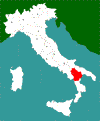Basilicata
Primary grape varieties:
White Grapes: Greco, Malvasia, Moscato
Red Grapes: Aglianico

Romans gave this region its present name, which is derived from the word 'basilikos' meaning both "prince" and "governor". Basilicata is divided into two provinces: Potenza and Matera. Virtually land-locked, this often neglected area of arid hills and desolate mountains with a small coast line on both the Tyrrhenian and lonian seas is prone to temperature extremes and can be bitterly cold for a southern region. The cool uplands benefit from a milder climate and are home to Basilicata's pride (and only DOC), 'Aglianico del Vulture'. The vine has been in the region since the 6th century BC when the Greeks planted it, its name being a corruption of the word "Hellenic" or Greek. Historically it was blended with the more famous wines of the Roman Empire to reinforce them for aging. Today, on the slopes of Mount Vulture, a spent volcano, Aglianico vines continue to wrestle nourishment from the lava-based soil, rich in potassium in some areas and in calcium and nitrogen in others. The vines produce an earthy, robust wine. Its power, structure, complexity and ability to age have earned the variety the name "Nebbiolo of the South." Somewhat similar to Barbera, it qualifies for the additional specification 'vecchio', (old) in three years, and 'riserva' in five.
Limited amounts of Malvasia and Moscato are also planted in the region producing dry to sweet still and sparkling wines.
The excessively steep and difficult terroir of Basilicata has led to a decline in the highland vineyards. New vineyards are found on gentler inclines and improved viticultural pratices are steadily advancing the area's wines.
